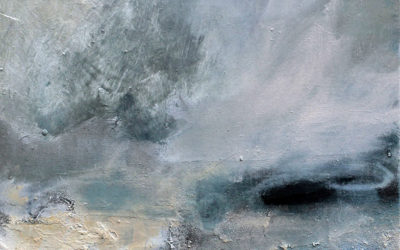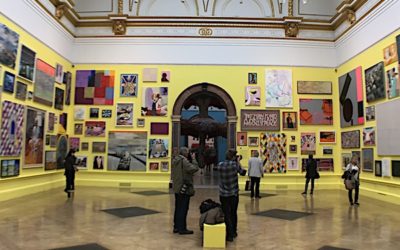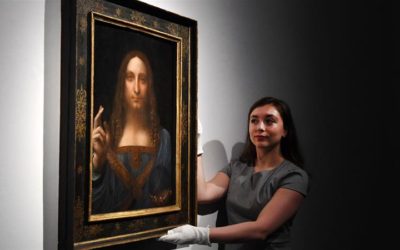Art News and Interviews
Visit the submission pages for details on how to feature your exhibition, your art, an interview or exhibition news.
Artist – Maria Pierides
In my paintings, I render in colour the stories of the physical and emotional landscapes that formed my experience of being born in Greece and then growing up in England and Cyprus and now living and working in Wales.
The actual process of my painting relates to this theme, as I use mixed media, building up and scraping back areas of paint to capture the atmosphere, mass, and light of the landscapes I am aiming to depict . In the series ‘The Gloaming,’ I explore ways of bringing these landscapes together and play with the similarities and contrasts: How being caught between two time perspectives – the Eastern Mediterranean is two hours ahead of England – two different kinds of light, two different cultures, results in both a feeling of richness and diversity of experience as well as a search for rootedness in the moment and in space.
UK show revives lost work of photographer who fled Nazis
Lost photographs from Weimar-era Berlin and 1930s London are to go on display, telling the remarkable story of a refugee fleeing the Nazis who has fallen through the gaps of art history.
Gerty Simon was an accomplished and successful photographer who staged exhibitions in Germany and Britain, but is barely known today.
Her subjects in Berlin included Albert Einstein and the singer Lotte Lenya, famous first for her thrilling performances of songs by her husband, Kurt Weill, and then 30 years later for her role as the terrifying Rosa Klebb in From Russia With Love. In London, she photographed Peggy Ashcroft, Kenneth Clark and Nye Bevan.
Simon’s work will this month go on display at the Wiener Library in London, the world’s oldest archive of material on the Holocaust and the Nazi era.

About 350 startling prints were left to the Wiener after the death in 2015 of Simon’s son, Bernard. Senior curator Barbara Warnock said they were anticipating an archive telling the life of Bernard, who was 12 when he came with his mother to London, not the photographs.
It soon became clear they needed to discover more about Gerty Simon. “The documentation seems to show that she was quite a prominent and famous photographer at the time but she’s been completely forgotten,” said Warnock. “It’s great to have this opportunity to get her work out there again.”
It is obvious from the Berlin photographs that Simon was well connected in the 1920s Berlin scene of actors, writers, composers, dancers and artists, as well as Social Democrat politicians.

One particularly striking portrait from 1929 is of a six-year-old girl, the late Judith Kerr, who would herself come to London with her family in 1933. She went on to find fame as a writer and illustrator of the Mog series and The Tiger Who Came to Tea.
Warnock said Simon and her son fled Berlin in 1933 and settled in Britain. She left behind her husband, who had been a judge and was permitted to carry on working as a notary, a reflection of how much paperwork Jewish families had to deal with.
Warnock said Simon felt unsafe after photographing so many Social Democrats. “She felt exposed, that she might be targeted. She left her husband, her home, her career, her studio to come to the UK.”
Within a short period of time she was photographing leading figures in London. “The impression you get is that she was a force of nature.”
Her work featured in a number of exhibitions, including one called London Personalities at the Storran Gallery in Kensington, west London, in 1934. One newspaper critic described her as a “most brilliant and original of Berlin photographers”.

Simon’s husband managed to join his family in London in 1939 and when war broke out was interned, as was his son and most German Jewish refugees.
It was particularly grim for Bernard as he was one of about 2,500 men, mostly German Jews, sent to Australia on the passenger ship Dunera. He managed to get back and when he did so he joined the Pioneer Corps.
Warnock said Bernard’s partner, on leaving the archive, said that he was not resentful about the internment and was grateful that Britain took in the family.
Simon seems to have stopped working as a photographer around the time of the war and has been somewhat forgotten. The Wiener hopes the show, part of a nationwide arts festival called Insiders/Outsiders celebrating the contribution of refugees from Nazi Europe, will go some way to rectifying that.
“Her photography career was quite short but rather brilliant,” said Warnock.
• Berlin/London: The Lost Photographs of Gerty Simon is on at the Wiener Library from 30 May-15 October.
guardian.co.uk © Guardian News & Media Limited 2010
Published via the Guardian News Feed plugin for WordPress.
The artist bringing the spirit of punk to the RA
When the painter Jock McFadyen was 17 years old, a truck pulled out in front of his Matchless motorbike. He swerved, but collided. He still remembers his relief that his head remained attached to his body, but his leg was shattered. “When I tried to stand up to attack the driver, my knee went the wrong way and I fainted,” he told me. “My foot was facing me in the eye and my shoes were on the other side of the road.”
The Lost Leonardo?
Salvator Mundi, the world’s most expensive painting, will not be part of this year’s big Leonardo da Vinci show in Paris because curators at the Louvre do not believe it can be attributed solely to the artist, it has been claimed.
The art historian and writer Ben Lewis has charted the remarkable story of a painting which made headlines all over the world when it sold for $450m (£354m) at Christie’s in New York in 2017.
(more…)Subscribe




